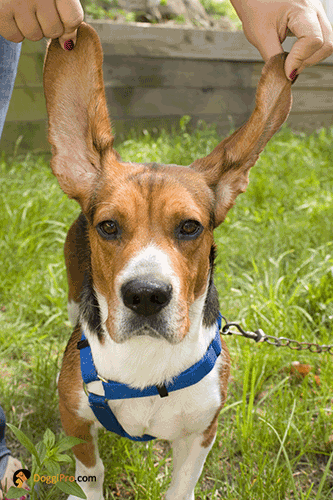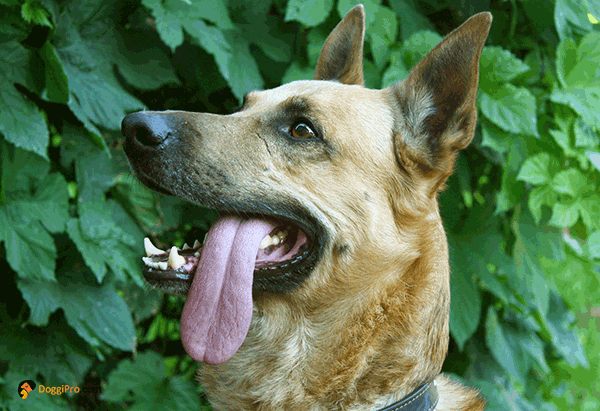I once got worried that my dog’s ears were unnaturally warm while touching them. I wanted to make sure everything was ok with my dog. I collected all the stuff I found regarding this dog condition in this article, I hope it helps you if you encounter the same situation.
Why is my dog’s ears hot? The excess heat could be an ear infection or an ear mite infestation. If unsure of the cause of the increase in heat, make sure to consult a professional veterinarian.
My Dog’s Ears Are Hot? Should I be Worried?
Some dogs will get ear infections, making their ears feel hot. Other signs include redness, swelling, and discharge. If this is your dog’s first ear infection, it is important to keep them out of water or other wet environments until the infection clears up.
Ear infections, in general, are common in dogs, and they can be uncomfortable for the dog since they will make their ears feel hot, and they will also have redness, swelling, and discharge coming from the ear. Bacteria often cause ear infections in dogs. Sometimes, yeast can also cause ear infections in dogs. Dogs with allergies, skin problems or swimming often are more prone to ear infections.
To reduce the chances of your dog getting an ear infection in the future, be sure to brush their teeth regularly and avoid feeding your dog processed foods that are high in sugar.
It is important to see your veterinarian if you notice any changes in your dog’s ears.
5 Common Reasons for Hot Ears in Dogs
Fever
The ears act as a way for dogs to regulate their body temperature by releasing heat if they are too warm.
The fever also causes increased blood flow to the ear, which increases the temperature in this area.
Infection
Like the human ear, blood vessels make up a dog’s ear. When dogs become infected, these vessels will swell and become warm. The ear canal will also be full of pus which causes an odorless discharge in the ear.
The infection in the dog’s ears can cause fever in some cases. If left untreated, it can spread to the brain and other parts of the body, which is very serious for dogs with weak immune systems.
Injury
Injury can cause a dog to become sensitive to temperature. This sensitivity is because the injury causes dogs to feel pain and makes them uncomfortable.
If you touch their ears, they will feel hotter because of the inflammation. Their ears will also be redder and more swollen than before the injury and have a wet feeling from excess blood flow or fluid buildup.
Allergies
Hot ears are a common symptom of allergies in dogs.
The body reacts to allergens by releasing histamine and other chemicals that cause inflammation and itchiness. One of the most common symptoms is a skin rash, but the ears, paws, and face can also be affected.
Ear Mites
Ear mites are tiny creatures you can only see through a microscope. They irritate the canine’s ear canal, leading to inflammation and discharge.
Many people do not know about this because it is hard to see them without a microscope. Dog owners need to identify ear mites in their dog’s ears because they can cause pain in the animal’s ears and make them very itchy.
Heatstroke
When a dog’s ears are hot, it is often due to excessive discharge of blood from the tissues of the ear. Dogs’ ears can also become hot when overheated or have an infection.
Excessive discharge of blood from the tissues of the ear will cause overheating, thus making the earshot.
Dogs can also get overheated by being active, staying outside for too long, having an infection in one of their ears, or living in a warm environment. A dog may also develop heatstroke due to underlying health conditions such as heart disease or cancer.
Playing
Playing with your dog can be a great way for you and your pet to bond and exercise. But it also has the potential to make their earshot. Dogs cannot regulate their body temperature as we do, so they rely on panting and their ears’ blood vessels to cool them off during playtime. When you are playing with your dog, it is possible for there to be an excessive amount of blood flowing through their ear’s blood vessels, which causes them to become warm or hot.
The best way for you to avoid this issue is by not letting the games go too long or too hard, especially when it is nearing bed time, which will allow them time in between playing sessions to cool off before they are ready for more activity.
Your Hands are Cold
Dog’s release heat through their heat to regulate their body temperature. If your hands are cold, touching your dog’s ear would feel warmer than normal.

Dog Ear Infection
The most common symptom of a dog ear infection is itchiness. Itchiness is localized to the ear or the area surrounding the ear.
Another symptom of dog ear infection is the accumulation of encrusted dirt and wax in the corners of the ears. If your dog has been scratching its ears with its paws, this could be a sign that there’s something wrong with them too.
Dog Ear Infection Symptoms
Other symptoms include inflammation, redness, excessive wax production, odor, and ear discharge.
The brown discharge can sometimes turn into a copious amount if left unchecked, which can lead to trouble breathing for your pet. This situation occurs when there’s an accumulation of pus in its ears and bacterial growth on its skin near its head and neck region.
The most worrying symptom a dog owner should look out for would be inflammation of the ears.
Ear Inflammation in Dogs
Dog ear inflammation is not a disease, but it can result from an allergy or bacterial, fungal, or yeast infection.
This condition is more common in dogs with allergies.
The symptoms are redness of the ear, itching, and scratching. Dogs with allergies will often have itchy, dry skin and inflamed ears.
Some studies have shown that up to 10% of dogs suffer from ear inflammation. Dogs who are especially prone to ear infections are those with floppy ears or those who spend a lot of time in the water.
How do Dogs get ear infections?
Dogs are more prone to ear infections than any other animal. A dog’s ear canals are horizontal, making it easier for fluid to become trapped and cause infection.
Ear infections in dogs usually occur when there is an accumulation of bacteria, yeast, or mites.
Parasites and bacteria can transmit dog shakes its head or scratches its ears after playing in an area infested with these foreign bodies.
Dogs with long hair, floppy ears, and droopy skin are more likely to have problems with ear infections than dogs with short hair and erect ears.
Many factors contribute to the development of an ear infection, including filth, excessive moisture, unclean ears, and an underlying skin disorder. Ear infections are often due to allergies or parasites. Ear infections can be common among dogs during the winter months because of the moist environment created under heavy coats.
An ear infection can cause your dog to shake its head excessively, scratch at his ears excessively, have inflammation in his eyes, and look very uncomfortable overall. If left untreated, the infection will spread deeper into your dog’s head and could lead to permanent damage or even deafness.
A veterinarian can diagnose an ear infection by looking at the color of the inside of the dog’s ears and examining if there is any discharge coming out of it.
Warning Signs to Look out for
Itching
If your dog suddenly keeps scratching their ears and whining, they are probably experiencing a lot of discomfort. This behavior is an easy sign to spot, and you should take your canine companion to the vet for a checkup.
Head-shaking
If your dog consistently shakes their head to get rid of something, it is a sign that there is a foreign body somewhere in its head. It should be a good time to have a vet take a look.
Smelly Ears
Unwelcome and pungent smells coming from your dog’s ears could mean an infection has grown out of control. There could be blood and pus, which is making the unwanted smell. Take your dog to the vet ASAP.
Dog Ear Infection Treatment
The vet will first look for ear mites, infections, or even cancer signs. Then they will use one of these to treat the ear infection:
- Oral medication
- Antibiotic ear drops
- Prednisone (steroids)
- Topical antibiotic ointment
If the infection persists, your pet may need hospitalization for intravenous antibiotic therapy.
If your pet is showing signs of an ear infection, you should take it to see your vet as soon as possible.
How To Treat A Dog Mild Ear Infection At Home
If your dog’s ear infection is mild, a few days of treatment can cure it. There are many different ways to treat a dog’s ear infection at home, but the most important thing is to make sure that the condition is not severe.
The first step in treating your dog’s mild ear infection without a vet is to clean the infected area with water and cotton balls. Then put in some antibiotic ointment in your pet’s ear canal, dirty it with cotton balls again, and leave it open for five minutes before you cover it with gauze or an adhesive bandage.
Avoid using cotton swabs as they can push debris further into the ear canal, which could cause more problems.
It would help if you were sure to keep your dog’s ears clean by massaging them gently when bathing them or when they are wet from playing outside.
How warm should a dog’s ears be?
Dogs have a higher body temperature than humans. Their normal body temperature range is between 99.5-102.5 degrees Fahrenheit (37.5 – 39.2 degrees Celcius). Naturally, dogs’ ears would feel warm to the touch. But if they feel unusually warm than normal, the best way to check if it’s a fever or not is to take their temperature with a thermometer.
Make sure to use a quality digital thermometer or a well-lubricated rectal thermometer to take your dog’s temperature.
What to do if my dog has a fever?
If your dog has a fever, you should be concerned about the canine fever and take proper actions. Knowing what to do when your dog has a fever is important to keep your pet healthy and safe.
Here are some steps that could help:
- Take your dog’s temperature with a digital thermometer
- Contact the vet if the temperature is 102.5 degrees Fahrenheit or more.
- Give medication if recommended by the vet
- Keep an eye on your dog for any other symptoms
The symptoms you will want to watch out for are lethargy, weakness, lack of appetite, vomiting, or diarrhea.
If your dog has any of these symptoms for more than 24 hours after the fever subsides, you should contact your veterinarian right away.
Consider the Fever an Emergency in the following conditions
- If there is a chance of poisoning
- If there are visible bites or stings
- If there is any visible injury or blood.
How to Lower my Dog’s Temperature
When your dog has a fever, the most important thing you should do is see your veterinarian. He will evaluate what’s causing the elevated temperature and administer the needed medication for treatment.
There are many ways to reduce your pup’s fever, including administering medication or cold water baths.
First, it is very important to know the exact temperature of your dog. If you don’t know, go ahead and take your dog’s temperature.
The following list of steps will guide reducing a dog’s temperature.
Step 1: Begin by laying your dog on a towel and patting them with a cool cloth for at least five minutes.
Step 2: If your pet is panting, you should wrap them in a wet towel iced in the freezer.
Step 3: Continue cooling your pet until their temperature lowers to where it should be.
How to keep your dog’s ears clean

A dog’s ears need cleaning to prevent discharge, infection, or drainage.
The discharge is a natural part of a dog’s ear. Dogs have a thin layer of skin that covers the opening of their ear canal, and this skin has glands that produce an oily substance called sebum. It is this sebum that causes the dark brown wax-like substance found in your dog’s ears.
The pet owner should care when cleaning the ear to avoid rupturing any blood vessels in the ear canal if they have fragile veins or are prone to bruising easily.
How to Clean Dog Ears
You can clean your dog’s ears without using any products by using these three easy steps:
1) Mix 1 part vinegar with two parts water.
2) Pour the mix in each ear.
3) Hold your dog’s head up and let them shake out the excess liquid.
Conclusion
Why are dogs’ earshot to the touch? Since dogs have a higher body temperature than humans, it’s only normal to feel warm to us. But, this is not the only reason.
Fur covers the whole body of your dog. When you touch your dog’s ears, you feel the hair covering the dog’s head. The coat on your dog’s head is typically much thicker than the fur on the rest of their body. The density of the hair is such that there are several layers to it. Each layer traps in body heat.
In addition, dogs have a great number of sweat glands on their body. These sweat glands secrete a lot of moisture and help keep them cool.
When you touch your dog’s ears, you are touching the skin that lies under the thick fur, and this is why they feel warm to our touch.
Dogs feel warm to our touch because of a combination of all these reasons.
The only worrying symptom is if your dog has a fever. If your has a fever, call your veterinarian for an appointment for your pet as soon as possible.
This article is accurate and true to the best of the author’s knowledge. It is not meant to substitute for diagnosis, prognosis, treatment, prescription, or formal and individualized advice from a veterinary medical professional. Animals exhibiting signs and symptoms of distress should be seen by a veterinarian immediately.
Source
“High Fever in Dogs,” Pets WebMD, last accessed January 4, 2022
- Why Shih Tzu Are The Worst Dog: An In Depth Analysis - February 7, 2024
- Why Schnauzers Are The Worst Dogs (or Are They?) - February 7, 2024
- Can dogs eat gushers? The Answer Might Suprise You - January 26, 2024

